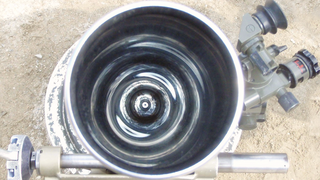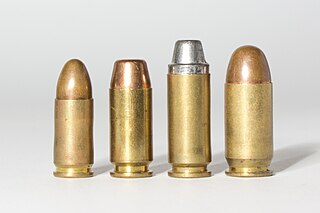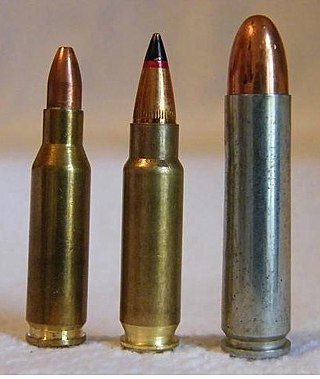This article needs additional citations for verification .(March 2014) |
Teflon-coated bullets, sometimes colloquially known as "cop killer bullets", are bullets that have been coated in polytetrafluoroethylene.
This article needs additional citations for verification .(March 2014) |
Teflon-coated bullets, sometimes colloquially known as "cop killer bullets", are bullets that have been coated in polytetrafluoroethylene.
In the 1960s, Paul Kopsch (an Ohio coroner), Daniel Turcus (a police sergeant), and Donald Ward (Kopsch's special investigator) began experimenting with special purpose handgun ammunition. Their objective was to develop a law enforcement round capable of improved penetration against hard targets, such as windshield glass and automobile doors. Conventional bullets, made primarily from lead, often become deformed and less effective after striking hard targets, especially when fired at handgun velocities. The inventors named their company "KTW," after their initials.
After some experimentation with sintered tungsten-alloy Kennertium W-10 projectiles, which were eventually abandoned due to supply and cost concerns, the inventors settled on a bullet consisting mostly of hard brass and some with a steel projectile. In testing, the comparatively hard brass bullets wore out barrels far more quickly than standard solid lead and copper-jacketed lead rounds, since they did not deform to fit the rifling. [1] In an attempt to reduce barrel wear, the steel projectiles had a copper cup which made contact with the rifling, on brass projectiles, brass driving bands are present to engage the rifling. Early KTWs were coated with Teflon. The inventors, having also noted that the tips of walking canes were frequently covered with the relatively soft and malleable Teflon to help them grip surfaces, found that the addition of Teflon helped to prevent bullet deflections from vehicle doors and windshields, further improving penetration against those surfaces. [2] [3]
In the late 1960s, KTW begun commercial production. In 1980, continued production of the ammunition was turned over to the North American Ordnance Corporation. The production of KTW-branded ammunition eventually ceased in the 1990s. However, some manufacturers continue to coat their bullets with various compounds, notably Teflon and molybdenum disulfide, as a protective layer against barrel wear.
Not a lot of performance data is available for these bullets, although the 9mm offering was reputed to push a 100- grain (6.5 g) projectile at a velocity of 1,350 feet per second (410 m/s).
In 1982, NBC broadcast a television special on Teflon-coated bullets that argued they were a serious threat to American law enforcement because of their supposedly increased ability to penetrate ballistic vests. This led various US gun control organizations to label these types of bullets with the epithet "cop killers". In 1983, US Representative Mario Biaggi reported that Du Pont Company officials agreed to stop selling teflon to individuals and companies that used it to make ammunition. [4]
Several calibers of KTW rounds were proven to penetrate ballistic vests under certain conditions. However, their inventor Kopsch said in a 1990 interview that "adding a Teflon coating to the round added 20% penetration power on metal and glass. Critics kept complaining about Teflon's ability to penetrate body armor [...] In fact, Teflon cut down on the round's ability to cut through the nylon or Kevlar of body armor." [2]
The federal ban on armor-piercing pistol ammunition uses only the composition of the bullet's core to determine legality. [5] However, many individual states have legislation restricting various kinds of coating materials, for example:

A bullet is a kinetic projectile, a component of firearm ammunition that is shot from a gun barrel. They are made of a variety of materials, such as copper, lead, steel, polymer, rubber and even wax; and are made in various shapes and constructions, including specialized functions such as hunting, target shooting, training, and combat. Bullets are often tapered, making them more aerodynamic. Bullet size is expressed by weight and diameter in both imperial and metric measurement systems. Bullets do not normally contain explosives but strike or damage the intended target by transferring kinetic energy upon impact and penetration.

A hollow-point bullet is a type of expanding bullet which expands on impact, causing a more lethal hit without penetrating further than necessary.

Terminal ballistics is a sub-field of ballistics concerned with the behavior and effects of a projectile when it hits and transfers its energy to a target.

The .50 Browning Machine Gun is a .50 in (12.7 mm) caliber cartridge developed for the M2 Browning heavy machine gun in the late 1910s, entering official service in 1921. Under STANAG 4383, it is a standard service cartridge for NATO forces as well as many non-NATO countries. The cartridge itself has been made in many variants: multiple generations of regular ball, tracer, armor-piercing (AP), incendiary, and saboted sub-caliber rounds. The rounds intended for machine guns are made into a continuous belt using metallic links.

The .45 ACP or .45 Auto (11.43×23mm) is a rimless straight-walled handgun cartridge designed by John Moses Browning in 1904, for use in his prototype Colt semi-automatic pistol. After successful military trials, it was adopted as the standard chambering for Colt's M1911 pistol. The round was developed due to a lack of stopping power experienced in the Moro Rebellion in places like Sulu. The issued ammunition, .38 Long Colt, had proved inadequate, motivating the search for a better cartridge. This experience and the Thompson–LaGarde Tests of 1904 led the Army and the Cavalry to decide that a minimum of .45 caliber was required in a new handgun cartridge.

A sabot is a supportive device used in firearm/artillery ammunitions to fit/patch around a projectile, such as a bullet/slug or a flechette-like projectile, and keep it aligned in the center of the barrel when fired. It allows a narrower projectile with high sectional density to be fired through a barrel of much larger bore diameter with maximal accelerative transfer of kinetic energy. After leaving the muzzle, the sabot typically separates from the projectile in flight, diverting only a very small portion of the overall kinetic energy.

A smoothbore weapon is one that has a barrel without rifling. Smoothbores range from handheld firearms to powerful tank guns and large artillery mortars.

The 9×19mm Parabellum is a rimless, tapered firearms cartridge.
The .30-06 Springfield cartridge, 7.62×63mm in metric notation, and called the .30 Gov't '06 by Winchester, was introduced to the United States Army in 1906 and later standardized; it remained in military use until the late 1970s. The ".30" refers to the caliber of the bullet in inches, .300 and the "06" refers to the year the cartridge was adopted, 1906. It replaced the .30-03, 6mm Lee Navy, and .30-40 Krag cartridges. The .30-06 remained the U.S. Army's primary rifle and machine gun cartridge for nearly 50 years before being replaced by the 7.62×51mm NATO and 5.56×45mm NATO, both of which remain in current U.S. and NATO service. It remains a very popular sporting round, with ammunition produced by all major manufacturers.

The 7.62×25mm Tokarev cartridge is a Soviet rimless bottlenecked pistol cartridge widely used in former Soviet states and in China, among other countries. The cartridge has since been replaced in most capacities by the 9×18mm Makarov in Russian service.

A headstamp is the markings on the bottom of a cartridge case designed for a firearm. It usually tells who manufactured the case. If it is a civilian case it often also tells the caliber: if it is military, the year of manufacture is often added.

Armor-piercing bullets for rifle and handgun cartridges are designed to penetrate ballistic armor and protective shields intended to stop or deflect conventional bullets. Although bullet design is an important factor with regard to armor penetration, the ability of any given projectile to penetrate ballistic armor increases with increasing velocity. Rifle cartridges typically discharge bullets at higher muzzle velocity than handgun cartridges due to larger propellant charge. However, even the same cartridge fired from a rifle will, in almost all common cases, have a higher velocity than when fired from a handgun. This is due to the longer period of acceleration available within the longer gun barrel of rifles, which allow adequate time for the propellant to fully ignite before the projectile exits the barrel. For this reason, bullets fired from rifles may be more capable of piercing armor than similar or identical bullets fired from handguns. In addition, a small-caliber bullet has higher sectional density than a larger-caliber bullet of the same weight, and thus is more capable of defeating body armor.
The 5.45×39mm cartridge is a rimless bottlenecked intermediate cartridge. It was introduced into service in 1974 by the Soviet Union for use with the new AK-74. The 5.45×39mm gradually supplemented and then largely replaced the 7.62×39mm cartridge in Soviet and Warsaw Pact service as the primary military service rifle cartridge.

The 14.5×114mm is a heavy machine gun and anti-materiel rifle cartridge used by the Soviet Union, the former Warsaw Pact, modern Russia, and other countries.

Armour-piercing fin-stabilized discarding sabot (APFSDS), long dart penetrator, or simply dart ammunition is a type of kinetic energy penetrator ammunition used to attack modern vehicle armour. As an armament for main battle tanks, it succeeds Armour-Piercing Discarding Sabot (APDS) ammunition, which is still used in small or medium caliber weapon systems.

Black Talon is a brand of hollow-point pistol and rifle ammunition introduced in 1991 by Winchester, primarily intended for law enforcement and personal defense use. Black Talon rounds were known for the unique construction of the bullet and its sharp petal shape after expansion following impact with tissue or other wet media. Black Talon ammunition was produced in the following calibers: 9mm Luger, 10mm Auto, .40 S&W, .45 ACP, .357 Magnum, .44 Magnum, .300 Winchester Magnum, .308 Winchester, .338 Winchester Magnum, and .30-06 Springfield.

Ammunition is the material fired, scattered, dropped, or detonated from any weapon or weapon system. Ammunition is both expendable weapons and the component parts of other weapons that create the effect on a target.

The 4.6×30mm cartridge is a small-caliber, high-velocity, smokeless powder, rebated rim, bottlenecked centerfire cartridge designed for personal defense weapons (PDW) developed by German armament manufacturer Heckler & Koch (HK) in 1999. It was designed primarily for the MP7 PDW to minimize weight and recoil while increasing penetration of body armor. It features a bottlenecked case and a pointed, steel-core, brass-jacketed bullet.

The FN 5.7×28mm is a small-caliber, high-velocity, smokeless-powder, rebated, bottleneck centerfire cartridge designed for handgun and personal defense weapons (PDW) uses, manufactured by FN Herstal. It is similar in length to the .22 WMR (5.7×27mm) and to some degree similar also to the .22 Hornet or .22 K-Hornet. Unlike many new cartridges, it has no parent case; the complete package was developed from scratch by FN.

The 7.62×39mm round is a rimless bottlenecked intermediate cartridge of Soviet origin. The cartridge is widely used due to the worldwide proliferation of Russian SKS and AK-47 pattern rifles, as well as RPD and RPK light machine guns.